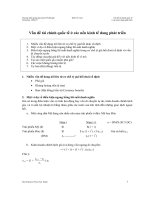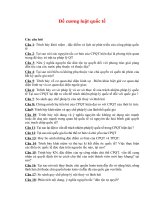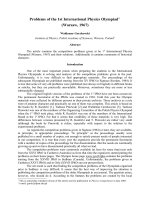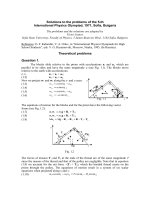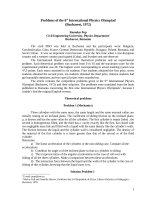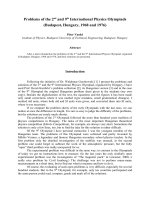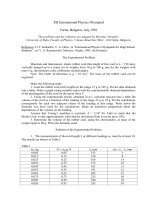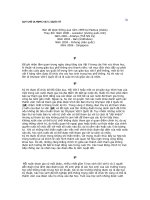Đề IPHO(vật lí quốc tế) 1972
Bạn đang xem bản rút gọn của tài liệu. Xem và tải ngay bản đầy đủ của tài liệu tại đây (1.44 MB, 15 trang )
Problems of the 6
th
International Physics Olympiad
(Bucharest, 1972)
Romulus Pop
Civil Engineering University, Physics Department
1
Bucharest, Romania
The sixth IPhO was held in Bucharest and the participants were: Bulgaria,
Czechoslovakia, Cuba, France, German Democratic Republic, Hungary, Poland, Romania, and
Soviet Union. It was an important event because it was the first time when a non-European
country and a western country participated (Cuba), and Sweden sent one observer.
The International Board selected four theoretical problems and an experimental problem.
Each theoretical problem was scored from 0 to 10 and the maximum score for the experimental
problem was 20. The highest score corresponding to actual marking system was 47,5 points.
Each team consisted in six students. Four students obtained the first prize, seven students
obtained the second prize, ten students obtained the third prize, thirteen students had got
honorable mentions, and two special prizes were awarded too.
The article contains the competition problems given at the 6
th
International Physics
Olympiad (Bucharest, 1972) and their solutions. The problems were translated from the book
published in Romania concerning the first nine International Physics Olympiads
2
, because I
couldn’t find the original English version.
Theoretical problems
Problem 1 (Mechanics)
Three cylinders with the same mass, the same length and the same external radius are
initially resting on an inclined plane. The coefficient of sliding friction on the inclined plane, μ,
is known and has the same value for all the cylinders. The first cylinder is empty (tube) , the
second is homogeneous filled, and the third has a cavity exactly like the first, but closed with
two negligible mass lids and filled with a liquid with the same density like the cylinder’s walls.
The friction between the liquid and the cylinder wall is considered negligible. The density of the
material of the first cylinder is n times greater than that of the second or of the third cylinder.
Determine:
a) The linear acceleration of the cylinders in the non-sliding case. Compare all the
accelerations.
b) Condition for angle α of the inclined plane so that no cylinders is sliding.
c) The reciprocal ratios of the angular accelerations in the case of roll over with sliding
of all the three cylinders. Make a comparison between these accelerations.
d) The interaction force between the liquid and the walls of the cylinder in the case of
sliding of this cylinder, knowing that the liquid mass is m
l
.
Solution Problem 1
1
E-mail:
2
Marius Gall and Anatolie Hristev, Probleme date la Olimpiadele de Fizica, Editura Didactica si Pedagogica –
Bucuresti, 1978
1
The inertia moments of the three cylinders are:
( )
,
2
1
44
11
hrRI
−=
πρ
24
22
2
1
2
1
mRhRI
==
πρ
,
( )
,
2
1
3
44
2
hrRI
−=
πρ
(1)
Because the three cylinders have the same mass :
( )
hRhrRm
2
2
22
1
πρπρ
=−=
(2)
it results:
2
1
2
1
2
22
,
1
11
ρ
ρ
ρ
ρ
=
−=
−=
n
n
RRr
(3)
The inertia moments can be written:
221
1
2 I
n
II
〉
−=
,
n
I
nn
II
1
23
11
2
=⋅
−=
(4)
In the expression of the inertia momentum
3
I
the sum of the two factors is constant:
2
11
2
=+
−
nn
independent of n, so that their products are maximum when these factors are equal:
nn
11
2
=−
; it results n = 1, and the products
1
11
2
=⋅
−
nn
. In fact n > 1, so that the products is
les than 1. It results:
I
1
> I
2
> I
3
(5)
For a cylinder rolling over freely on the inclined plane (fig. 1.1) we can write the equations:
maFmg
f
=−
α
sin
(6)
0cos
=−
α
mgN
ε
IRF
f
=
(7)
where ε is the angular acceleration. If the cylinder doesn’t slide we have the condition:
Ra
ε
=
(8)
Solving the equation system (6-8) we find:
2
1
sin
mR
I
g
a
+
=
α
,
I
mR
mg
F
f
2
1
sin
+
=
α
(9)
2
The condition of non-sliding is:
F
f
< μN = μmgsinα
tgα <
+
1
2
1
I
mR
µ
(10)
In the case of the cylinders from this problem, the condition necessary so that none of them
slides is obtained for maximum I:
12
14
1
1
2
−
−
=
+〈
n
n
I
mR
tg
µµα
(11)
The accelerations of the cylinders are:
)
1
1(3
sin2
1
n
g
a
−+
=
α
,
3
sin2
2
α
g
a
=
,
2
3
)
1
1(3
sin2
n
g
a
−−
=
α
. (12)
The relation between accelerations:
a
1
< a
2
< a
3
(13)
In the case than all the three cylinders slide:
αµµ
cosmgNF
f
==
(14)
and from (7) results:
αµε
cosmg
I
R
=
(15)
for the cylinders of the problem:
Fig. 1.1
3
n
nIII
:
1
1:1
1
:
1
:
1
::
321
321
−==
εεε
ε
1 <
ε
2
< ε
3
(16)
In the case that one of the cylinders is sliding:
maFmg
f
=−
α
sin
,
αµ
cosmgF
f
=
, (17)
( )
αµα
cossin
−=
ga
(18)
Let
F
be the total force acting on the liquid mass m
l
inside the cylinder (fig.1.2), we can write:
( )
αµαα
cossinsin
−==+
gmamgmF
lllx
,
0cos
=−
α
gmF
ly
(19)
φ
α
µα
cos
cos
1cos
222
gmgmFFF
llyx
=+⋅=+=
(20)
where
φ
is the friction angle
( )
µφ
=
tg
.
Problem 2 (Molecular Physics)
Two cylinders A and B, with equal diameters have inside two pistons with negligible
mass connected by a rigid rod. The pistons can move freely. The rod is a short tube with a valve.
The valve is initially closed (fig. 2.1).
A
B
4
Fig. 2.1
Fig. 1.2
The cylinder A and his piston is adiabatically insulated and the cylinder B is in thermal contact
with a thermostat which has the temperature θ = 27
o
C.
Initially the piston of the cylinder A is fixed and inside there is a mass m= 32 kg of argon at a
pressure higher than the atmospheric pressure. Inside the cylinder B there is a mass of oxygen at
the normal atmospheric pressure.
Liberating the piston of the cylinder A, it moves slowly enough (quasi-static) and at equilibrium
the volume of the gas is eight times higher, and in the cylinder B de oxygen’s density increased
two times. Knowing that the thermostat received the heat Q
’
=747,9.10
4
J, determine:
a) Establish on the base of the kinetic theory of the gases, studying the elastic collisions of
the molecules with the piston, that the thermal equation of the process taking place in the
cylinder A is TV
2/3
= constant.
b) Calculate the parameters p, V, and T of argon in the initial and final states.
c) Opening the valve which separates the two cylinders, calculate the final pressure of the
mixture of the gases.
The kilo-molar mass of argon is μ = 40 kg/kmol.
Solution Problem 2
a) We consider argon an ideal mono-atomic gas and the collisions of the atoms with the
piston perfect elastic. In such a collision with a fix wall the speed
v
of the particle changes only
the direction so that the speed
v
and the speed
'v
after collision there are in the same plane
with the normal and the incident and reflection angle are equal.
nn
vv
−=
'
,
tt
vv
=
'
(1)
In the problem the wall moves with the speed
u
perpendicular on the wall. The relative speed
of the particle with respect the wall is
uv
−
. Choosing the Oz axis perpendicular on the wall in
the sense of
u
, the conditions of the elastic collision give:
( )
( )
zz
uvuv
−−=−
'
,
( )
( )
yxyx
uvuv
,
'
,
−=−
;
( )
uvuv
zz
−−=−
'
,
zz
vuv
−=
2
'
,
yxyx
vv
,
'
,
=
(2)
The increase of the kinetic energy of the particle with mass
o
m
after collision is:
( )
( )
zozozzooo
uvmvuumvvmvmvm 22
2
1
2
1
2
1
22'22'
−≅−=−=−
(3)
because u is much smaller than
z
v
.
If
k
n
is the number of molecules from unit volume with the speed component
zk
v
, then the
number of molecules with this component which collide in the time dt the area dS of the piston
is:
dtdSvn
zkk
2
1
(4)
These molecules will have a change of the kinetic energy:
( )
dVvnmuvmdtdSvn
zkkozkozkk
2
2
2
1
−=−
(5)
where
udtdSdV
=
is the increase of the volume of gas.
The change of the kinetic energy of the gas corresponding to the increase of volume dV is:
5
dVvnmvndVmdE
o
k
zkkoc
22
3
1
−=−=
∑
(6)
and:
V
dV
U
V
dV
vm
NdU
o
3
2
23
2
2
−=⋅−=
(7)
Integrating equation (7) results:
.
3/2
constUV
=
(8)
The internal energy of the ideal mono-atomic gas is proportional with the absolute temperature T
and the equation (8) can be written:
.
3/2
constTV
=
(9)
b) The oxygen is in contact with a thermostat and will suffer an isothermal process. The
internal energy will be modified only by the adiabatic process suffered by argon gas:
TmcTCU
VV
∆=∆=∆
ν
(10)
where
ν
is the number of kilomoles. For argon
RC
V
2
3
=
.
For the entire system L=0 and
QU
=∆
.
We will use indices 1, respectively 2, for the measures corresponding to argon from cylinder A,
respectively oxygen from the cylinder B:
( )
−
⋅==−⋅⋅=∆ 1
2
3
2
3
3/2
'
1
1
1
1
1
1
'
1
1
1
V
V
RT
m
QTTR
m
U
µµ
(11)
From equation (11) results:
K
V
V
R
Q
m
T 1000
1
1
3
2
3/2
'
1
1
1
1
1
=
−
⋅⋅⋅=
µ
(12)
K
T
T 250
4
1
'
1
==
(13)
For the isothermal process suffered by oxygen:
2
'
2
2
'
2
p
p
=
ρ
ρ
(14)
25'
2
/10026,200,2 mNatmp ⋅==
From the equilibrium condition:
atmpp 2
'
2
'
1
==
(15)
For argon:
25
'
1
1
1
'
1
'
11
/109,6464 mNatm
T
T
V
V
pp
⋅==⋅⋅=
(16)
3
1
'
1
3
1
1
1
1
1
16,88,02,1 mVVm
p
RTm
V
===⋅=
µ
(17)
6
